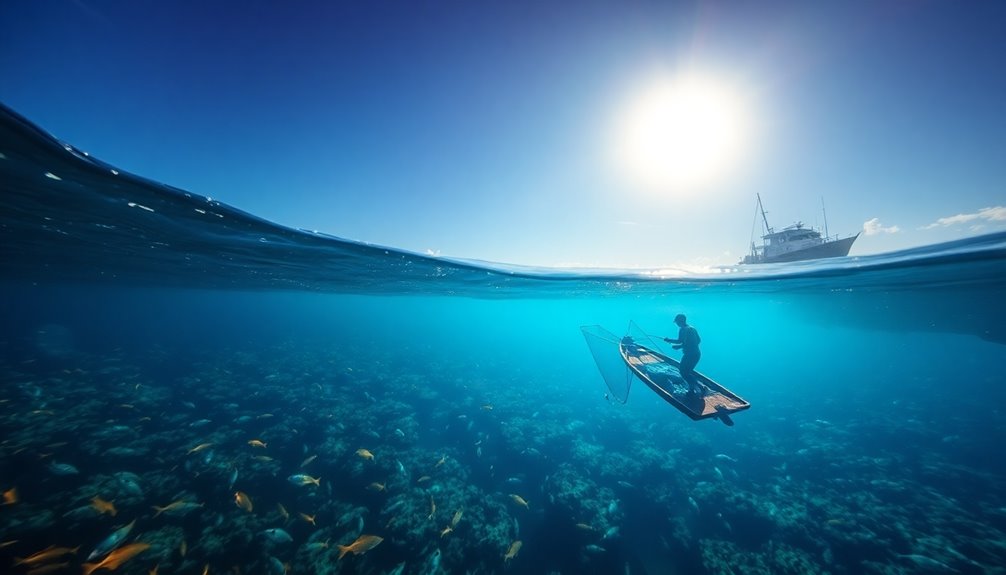Overfishing could strangely guide us toward sustainability. By recognizing the problem and adopting sustainable fishing practices, you can help restore marine ecosystems. Implementing quotas allows fish populations to recover, while community-led management engages local fishers in protecting resources. Technology enhances monitoring and promotes informed choices, ensuring a balance between consumption and conservation. With dedication to these approaches, you can be part of the solution. Discover how you can make a difference and support sustainable practices.
Key Takeaways
- Overfishing highlights the urgent need for sustainable fishing practices to restore fish populations and maintain marine ecosystems.
- Implementing quotas and limits can balance fishing demands while ensuring fish species have time to reproduce effectively.
- Marine Protected Areas (MPAs) create safe zones that promote biodiversity and can enhance nearby fish populations, supporting sustainable fisheries.
- Community engagement in decision-making fosters innovative, locally-driven solutions to manage fish stocks sustainably and protect marine resources.
- Technological advancements enable better monitoring of fish populations and habitats, facilitating data-driven management strategies for sustainable fishing.

Overfishing poses a serious threat to our oceans, as fish are caught faster than they can reproduce, leading to a decline in global fish populations. This issue not only affects the targeted species but disrupts entire marine ecosystems, resulting in biodiversity loss that can destabilize food chains.
You mightn't realize it, but the livelihoods of many communities depend on these fish for subsistence. When fish populations dwindle, it impacts their ability to sustain themselves and their families.
However, there's a silver lining. By adopting sustainable fishing practices, you can help reverse the damaging effects of overfishing. Implementing quotas and limits allows fish populations to recover, ensuring that you'll have access to seafood now and in the future. Sustainable fishing practices can secure future food supplies and combat poverty and hunger. Additionally, embracing continuous learning about sustainable methods can empower fishers to innovate and improve their practices.
Using selective fishing gear can minimize bycatch, preserving non-target species and contributing to the overall health of marine ecosystems. Marine Protected Areas (MPAs) are essential, too, as they provide safe havens for fish to thrive and repopulate.
You may wonder how individual actions can make a difference. Engaging in community-led management approaches can create a sense of ownership among fishers, fostering sustainable practices. When you participate in decision-making, it strengthens the commitment to protect marine resources.
Moreover, technology plays a vital role. Using advanced monitoring systems can help enforce fishing quotas effectively.
As awareness grows about the importance of sustainable fishing, you can support initiatives that reduce the environmental impact of fishing. By choosing sustainable seafood, you not only contribute to healthier oceans but also ensure food security for generations to come.
The potential for reversing overfishing trends is within reach if we all commit to sustainable practices. Embracing these methods can balance economic stability with ecological health, paving the way for a more sustainable future for our oceans.
Frequently Asked Questions
What Are the Main Causes of Overfishing Globally?
The main causes of overfishing globally include an excessive number of fishing vessels and advancements in technology that boost efficiency.
You'll find that government subsidies encourage unsustainable practices, while rising market demand for seafood drives fleets to catch more than ecosystems can handle.
Additionally, illegal and unregulated fishing, along with weak enforcement of regulations, further depletes fish stocks, threatening biodiversity and food security for communities reliant on marine resources.
How Does Overfishing Impact Marine Ecosystems?
When you think about the ocean's delicate balance, overfishing seems like a misguided attempt to capture abundance. It disrupts marine ecosystems by depleting key species, leading to a cascade of ecological changes.
You might notice less biodiversity, and habitats suffer from destructive practices. This imbalance can even result in ecosystem collapse, impacting not just marine life but also the communities that depend on these waters.
It's a cycle that ultimately threatens our shared ocean heritage.
What Are the Economic Consequences of Overfishing?
Overfishing leads to significant economic consequences that you can't ignore.
You might see annual losses of about £36 billion globally due to dwindling fish populations. This reduces job opportunities in fishing and related sectors, affecting coastal communities that depend heavily on fishing for their livelihoods.
As fish stocks decline, food prices rise, making it harder for low-income households to access nutritious meals, ultimately risking malnutrition and increasing unemployment in the industry.
Are There Successful Case Studies of Sustainable Fishing Practices?
Yes, there are successful case studies of sustainable fishing practices.
For example, the Lyme Bay Fisheries and Conservation Reserve in the UK showcases how collaboration between fishers, conservationists, and regulators can restore seabed habitats and boost shellfish catches.
By implementing voluntary codes and real-time monitoring, communities can enhance sustainability while improving local livelihoods.
These practices not only protect marine biodiversity but also offer a scalable model for other regions to replicate.
How Can Consumers Contribute to Sustainable Fishing Efforts?
You can contribute to sustainable fishing efforts by choosing seafood with eco-labels like the Marine Stewardship Council (MSC).
Educate yourself about various fish species to spread demand and reduce pressure on overfished populations. Support restaurants and markets that prioritize sustainable sourcing.
Participate in awareness campaigns and advocate for responsible fishing practices in your community.
Conclusion
As we navigate the turbulent waters of overfishing, you might find that sometimes a storm can lead to a clearer horizon. By embracing innovative practices and responsible management, you can turn the tide towards sustainability. It's like tending a garden; with careful pruning and nurturing, you can help the ocean flourish again. So, let's cast our nets wisely, ensuring the bounty of the sea thrives for generations to come, transforming the plight of overfishing into a path of hope.









